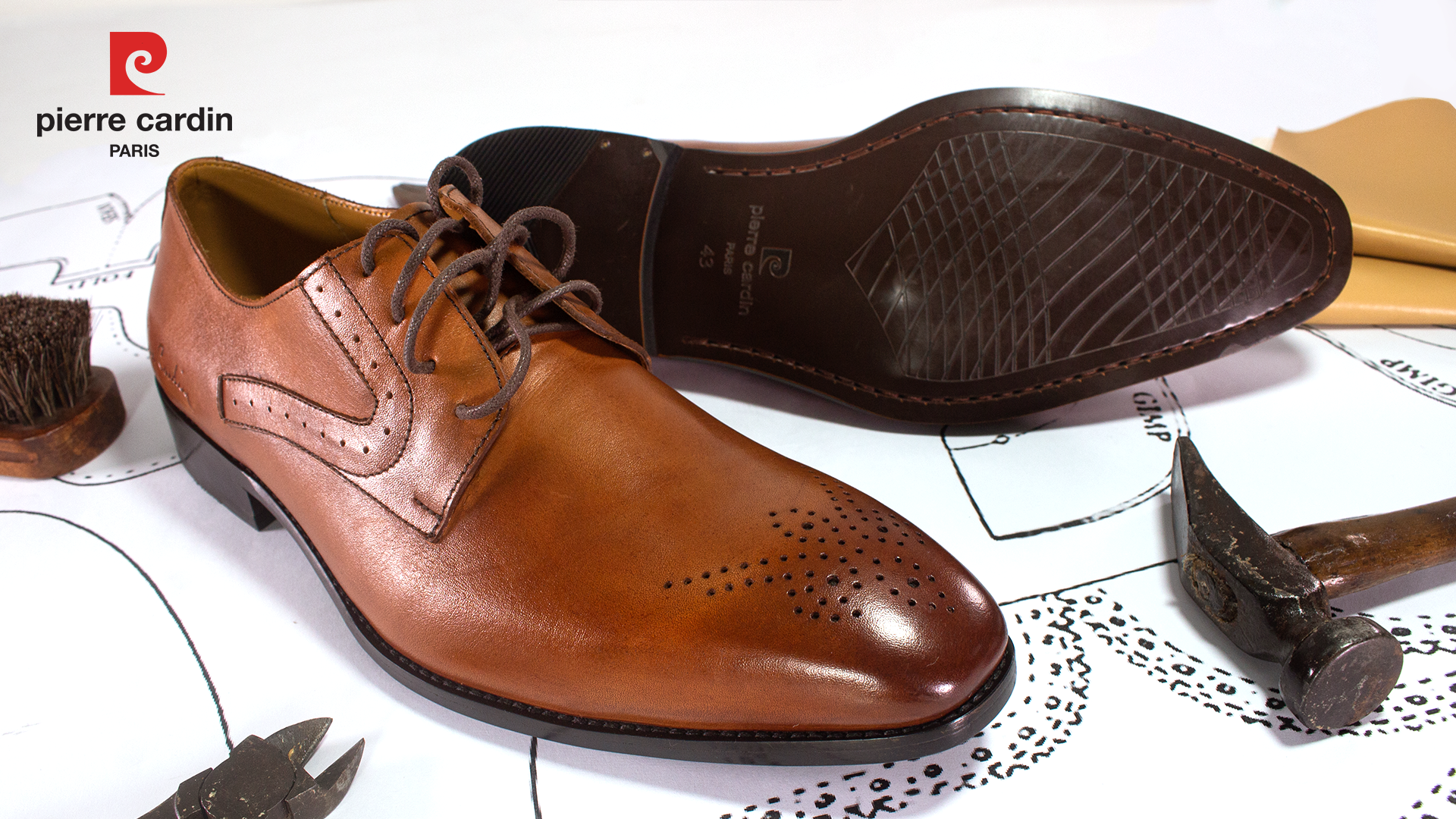 Hiện chưa có sản phẩm |
| TỔNG TIỀN: | 0₫ |
| Xem giỏ hàng | Thanh toán |
Pierre Cardin is a premium fashion brand from Paris (France). In Vietnam, Pierre Cardin is The Number One Of Dress Shoes And Accessories Systems, which has more than 100 retail locations across 50 provinces and cities.
On the occasion of 10 years of accompanying our Vietnamese customers, Pierre Cardin Paris Vietnam is honored to share the proudful story of a journey creating wonderful Handcrafted Dress Shoes that we have constantly pursued years-by-years.
Handcrafted Dress Shoes Pierre Cardin goes through 200 crafting steps, taking two days to complete. For premium Dress Shoes, material and crafting technique are essential factors determining the shoe's value.
Pierre Cardin Dress Shoes are made from premium 100% imported cowhide leather. Each leather is carefully selected, evaluated, and removed any defects (scratches, damage, ...) before use.
(Figure 1 - Handcrafted Shoe Leather materials were strictly selected)
Artisans use leather only in each shoe component to ensure its leather quality. For example: the toe shoe is made entirely from the back or belly leather to help minimize issues with uneven color, texture, or leather longevity.
After the leather material is meticulously selected, Pierre Cardin Handcrafted Dress Shoes undergoes many stages to perfect fundamental components such as:
For the vamp, artisans cut the leather into pieces and assemble them to create the outsole surface and inner lining of the shoe. To ensure the shoe holds its shape, artisans use "toe puffs" on the toe, two sides, and heel of the shoe. These reinforcements are sandwiched between the outer surface and inner lining.
(Figure 2 - “Lines” Inside Of Dress Shoes Pierre Cardin has full grain 1 Cowhide Leather)
Two sides of the shoe, especially the side reinforcements, play a crucial role in determining the shoe's shape and strength, as they bear the most stress. If using a material for the sole that is not sufficiently durable, the shoes will lose their shape. The sole can deform or protrude if it is too thick and rough. Artisans use full grain 1 Cowhide Leather because of its durability, flexibility, and the prevention of bulkiness, ensuring precision in every detail of Handcrafted Shoes Pierre Cardin.
(Figure 3 - Creating Brogue patterns process on the Handcrafted Dress Shoes Pierre Cardin)
For Dress Shoes with Brogue patterns (punched holes), artisans use hammers and punches to create the holes entirely by hand. The force applied must be precise to avoid damaging the leather and to maintain uniformity. After the preparation phase, artisans proceed to sew the vamp. At this stage, artisans must move the leather on the sewing machine gently and skillfully. After completion, the product checks thorough quality inspection, examining each seam before moving on to the molding phase.
In the shoe last stage, artisans attach the vamp to a foot last (France: Forme) that has a pre-fitted insole. Then, a machine is used to stretch the leather, fixing the shoe toe and heel of the shoe into the last.
(Figure 4 - Shaping the sides of the shoe process)
For the shoe's sides, artisans must manually shape them. Because each leather has different stretchability and characteristics and unique shoes last, therefore, artisans combine their experience and intuition to form the shoe sides neither too tight nor too loose. The hammer used for shaping must glide smoothly over the leather's surface to avoid damaging the premium Cowhide Leather.
With Leather Soles, Pierre Cardin Paris offers two types of sole stitching: traditional welt stitching (visible stitching) and concealed stitching. With concealed stitching, Customers will not see any stitching lines on the Leather Sole.
(Figure 5 - Leather Shoe Pierre Cardin with the concealed stitching technique)
To achieve this, artisans "skive" (thinly cut) the edge of the leather sole, creating an additional thin layer of leather that covers the stitching lines. This is an intricate technique because each layer of leather has a standard thickness of 1.2 - 1.8mm.
(Figure 6 - Pierre Cardin Paris Vietnam: Pierre Cardin Deluxe Classic Oxford Shoes - PCMFWLE 330)
*Pierre Cardin Shoes - PCMFWLE 330 with Concealed Stitching Technique: https://pierre-cardin.vn/products/giay-tay-de-da-cao-cap-pierre-cardin-cao-cap-pcmfwle-330
(Figure 7 - Pierre Cardin Paris Vietnam: Pierre Cardin Wholecut Oxford Shoes- PCMFWLG 356)
*Pierre Cardin Oxford Shoes - PCMFWLG 356 with Self-Creation Sole Technology: https://pierre-cardin.vn/products/giay-wholecut-oxford-de-da-phong-cach-hoang-gia-pierre-cardin-pcmfwlg-356
The Custom - Made Sole is a creatively designed sole that combines Rubber Soles and Leather Shoe to enhance traction, prevent slipping and give the unique sole’s design. With this type of Custom-Made Sole, artisans manually glue Leather Sole pieces onto the Rubber Sole.
(Figure 8: Custom-Made Sole of Premium Dress Shoe Pierre Cardin)
After completing the Leather Sole or Custom-Made Sole, artisans will sew sole shoes. This is the most explicit demonstration of the connection between Western aesthetics and Vietnamese crafting technique. It is also the most complex step, requiring highly skilled artisan. Handcrafted Shoe Pierre Cardin are crafted based on the McKay/ Good-year handcrafted sole stitching technique over 150 years in Europe.
The McKay/ Good-year sole stitching technique is characterized by a layer of cork between the insole and outsole shoe. The cork layer molds to the foot frame over time, creating a unique fit for each individual. Handcrafted Shoes are unique works, offering an extremely comfortable experience. Unlike the Cement construction method, McKay/Goodyear is a "stitched sole" technique, which ensures the durability of Premium Shoes.

(Figure 9 - Dress Shoes Pierre Cardin making based on the McKay/ Good-year technique)
However, McKay and Good-year differ significantly in their technical execution. In the Goodyear method, artisans use a strip of "welt" leather - stitched onto the insole and toe. They then continue to stitch the outsole to the welt leather. This technique demands highly skilled artisans. They use an awl to puncture holes in the leather and then employ up to two needles to securely stitch the welt. Notably, both the awl and needles are flat, not pointed.
Therefore, every step must be precise, and the needles must be both skillfully and firmly manipulated to avoid stretching the leather or damaging the material. Thanks to this welt construction, Goodyear Shoes can easily have their Leather Sole replaced (up to 3 times) to prevent water infiltration from the outside.
(Figure 10: The McKay/ Good-year sole stitching technique of Pierre Cardin)
With the McKay technique, artisans directly use machinery to sew the outsole without the welt leather. Consequently, McKay soles help minimize the replacing ability of the soles after prolonged use. They are also more susceptible to water infiltration and external environmental impacts compared to Goodyear soles.
(Figure 11 - Leather Shoe Pierre Cardin Sharpening Technology)
After stitching the outsole using the McKay/ Good-year technique, the Handcrafted Dress Shoes are essentially shaped. Artisans continue to trim excess leather around the edges of the sole. There is no fixed method for this sharpening process because shoes are different from the hand shaping process. Artisans take advantage of their experience and intuition to determine the extent to trim the leather, ensuring the sole is perfectly balanced with the overall shoe. On average, it takes 3 - 4 years of artisan experience to master the sole sharpening.
The distinction begins from the material selection, precision cutting, meticulous shaping, and the handcrafted sole stitching technique. Handcrafted Dress Shoes apply the Leather Patina painting technique, skilled artisans engage in manual procedures to complete.
(Figure 12: Patina handcrafted paint finish technique of Pierre Cardin)
Patina is a paint finish technique to create splash or color change effects on the shoe's surface. Because the absorption capacity of each leather piece varies, skilled artisans use a sponge to spread paint color. Artisans systematically apply successive layers of paint, relying upon their acute color sensitivity to craft the ultimate masterpiece. Hence, Patina Handcrafted Shoes epitomize the most exclusive product.
(Figure 13: Patina handcrafted paint finish technique of Pierre Cardin)
*Handcrafted Dress Shoe Pierre Cardin based on the Patina painting technique: https://pierre-cardin.vn/products/giay-oxford-de-da-cao-cap-phong-cach-hoang-gia-pierre-cardin-pcmfwlg-355
Finally, the artisans perform the last finishing steps such as polishing, leather ironing, and grinding. The products undergo strict quality control inspections before reaching the hands of the customers.
Handcrafted Dress Shoes Pierre Cardin are truly works of art shaped by the skilled hands of many dedicated artisans. And Customers will complete the products by molding feet on the cork layer. This uniqueness is the core value of premium fashion, creating European Handcrafted Dress Shoes for Vietnamese consumers.
Pierre Cardin Paris continually develops, satisfying the needs of today and the future. In the Handcrafted Shoe Pierre Cardin factory, we provided the opportunity for young artisans to learn and practice. Each craftsman experiences comprehensive training covering 200 shoe making processes and then specializes to maximize their skills.
Pierre Cardin Paris Vietnam values customer feedback and uses it to improve product, sizes, and styles. A notable example is the innovation of shoe sizes 38 and 44 for all Dress Shoes Pierre Cardin.
This is the story of the journey to design Pierre Cardin's masterpieces, from Paris to Vietnam, from the skilled hands of artisan to the exclusive Handcrafted Shoes. Pierre Cardin Paris Vietnam is grateful to thank Customers for their trust and loyalty to our values over the past 10 years. We are honored to have been your companion on this journey.
*Read more: Pierre Cardin Paris Vietnam: “From 38 to 44 - More Than Just A Shoe Size Story"
Pierre Cardin Paris Vietnam
(2023)
Content Creator: Nguyễn Hà Bảo Thy
Translator: Lê Lâm Bảo Ngọc